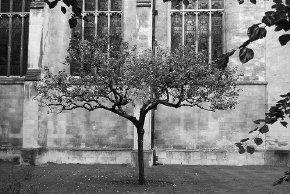069
The Apple Tree, Trinity College, Cambridge, England
 52° 12′ 26.22″ N, 0° 7′ 3.98″ E
52° 12′ 26.22″ N, 0° 7′ 3.98″ E
![]()
The System of the World
Sir Isaac Newton, arguably one of the greatest scientists of all time, lived and worked at Trinity College at the University of Cambridge for much of his life. Just outside Newton’s old rooms is an apple tree believed to be descended from a tree at Newton’s home in Woolsthorpe, Lincolnshire: the tree that inspired Newton’s theory of gravitation (Figure 69-1).

Figure 69-1. Newton’s apple tree at Trinity College, Cambridge; courtesy of Fred Parkins
Newton is not the only famous scientific alumnus of Trinity College; Trinity was the one-time home of Lord Rayleigh, J. J. Thomson, Ernest Rutherford, Niels Bohr, Sir William Henry Bragg, and 21 other Nobel Prize winners. Newton was Cambridge University’s Lucasian Professor of Mathematics (a post currently held by Stephen Hawking and previously held by Charles Babbage and Paul Dirac, among others).
Newton’s great contribution, published in 1687 in his Philosophiæ Naturalis Principia Mathematica, is the law of universal gravitation and his three laws of motion. These showed that Kepler’s laws about the motion of planets—that the Earth did revolve around the Sun—were correct, and gave the reason: gravity.
The law of universal gravitation is that two bodies (such as planets, but also apples) exert a gravitational force on each other. The force is proportional to the product of the masses of the bodies (the larger the body, the more force is exerted) and inversely proportional to the square of the distance between them.
This inverse-square law shows that the further the bodies are apart, the weaker the force, and that doubling the distance between two bodies results in a force 1/4 of the strength. Inverse-square laws abound: electromagnetic radiation (including light and ordinary radio transmissions) diminishes with the square of the distance between the source and the receiver; the force of attraction between two electrically charged particles does the same; and even the intensity of sounds diminishes with the square of the distance.
Newton’s three laws of motion govern how forces act on bodies:
1. If no force is applied to a body, it either stays where it was, or keeps moving at a constant speed.
2. If a force is applied to a body, then its acceleration is proportional to the force, and inversely proportional to the body’s mass. The acceleration occurs in the direction of the force.
3. If a body A exerts a force on body B, then the opposite is true; in other words, every action has an equal and opposite reaction.
Newton’s own copy of Philosophiæ Naturalis Principia Mathematica is kept in the Trinity College library, as well as many other books that he wrote or owned.
A visit to Trinity starts with Newton’s apple tree just outside the Great Gate. Once inside, you’re standing in the Great Court, the largest courtyard of any Oxford or Cambridge college. Many of the university’s colleges are built around courtyards, and this one is well known to filmgoers as the setting for the race in Chariots of Fire. The college clock used in the film (and in real life) to time races around the courtyard has been in use since the 1700s.
Surrounding the courtyard you’ll see the college chapel, the Master’s Lodge, and the Hall (where students eat). In the middle is a fountain that until recently was fed from a spring; the fountain is believed to have been used by students for washing. Standing in this famous courtyard, it’s not hard to imagine Newton working here: little seems to have changed.
In the second courtyard you’ll find the Wren Library, designed by Sir Christopher Wren. The library is open to the public and includes a bust of Newton. Behind the library is the River Cam, where students and visitors alike can try their hand at punting: navigating a flat-bottomed boat by pushing it with a 5-meter-long pole. To propel the punt, stand at the back of the boat, drop the pole straight down into the water (under the force of gravity, or with a little push), and push on the pole to drive the punt forward. Once you’ve got the punt moving, let the pole float to the surface and use it as a rudder until the next push is needed. The greatest danger in punting is pushing too hard, getting the pole stuck in the muddy river bottom, and realizing that you can either fall in trying to pull it out, or let the pole go. (Oars are usually provided for those who choose to not fall in.)
If you do make it down the river, you’ll come to Queens’ College and a pretty wooden bridge spanning the Cam. Don’t believe the stories about this being a “mathematical bridge” built by Newton. It was built after his death, has been rebuilt twice since, and is called simply the Wooden Bridge.
Practical Information
Trinity College is open to the public. For information on reaching the college and a proposed tour of the buildings and grounds, see its website at http://www.trin.cam.ac.uk/.
